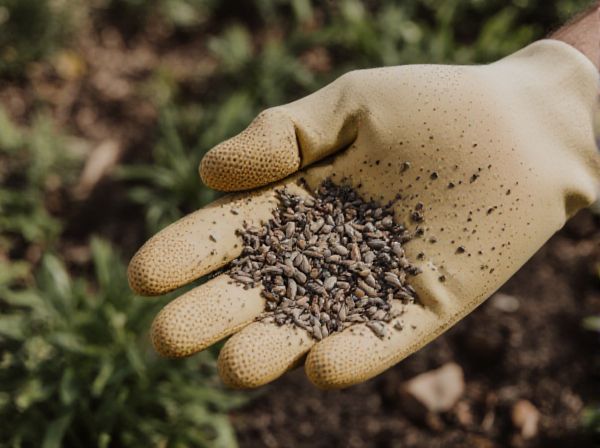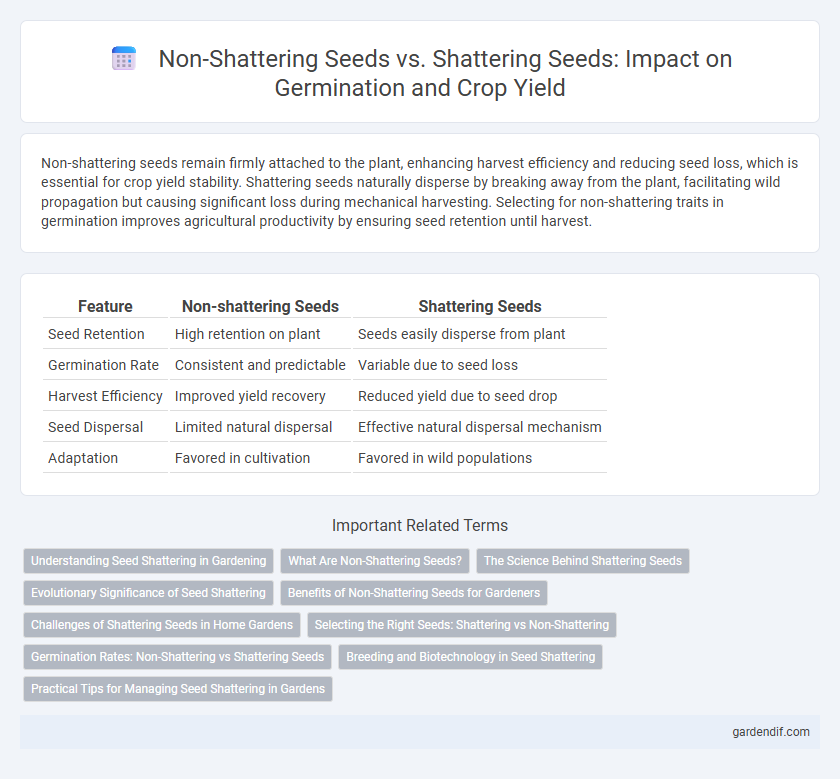
Non-shattering Seeds vs Shattering Seeds Illustration
Non-shattering seeds remain firmly attached to the plant, enhancing harvest efficiency and reducing seed loss, which is essential for crop yield stability. Shattering seeds naturally disperse by breaking away from the plant, facilitating wild propagation but causing significant loss during mechanical harvesting. Selecting for non-shattering traits in germination improves agricultural productivity by ensuring seed retention until harvest.
Table of Comparison
| Feature | Non-shattering Seeds | Shattering Seeds |
|---|---|---|
| Seed Retention | High retention on plant | Seeds easily disperse from plant |
| Germination Rate | Consistent and predictable | Variable due to seed loss |
| Harvest Efficiency | Improved yield recovery | Reduced yield due to seed drop |
| Seed Dispersal | Limited natural dispersal | Effective natural dispersal mechanism |
| Adaptation | Favored in cultivation | Favored in wild populations |
Understanding Seed Shattering in Gardening
Seed shattering refers to the natural dispersal mechanism where mature seeds are forcibly released from the seed pod, a trait common in wild plants but often undesirable in gardening due to seed loss. Non-shattering seeds retain firmly within the pod, allowing gardeners to harvest seeds more efficiently and improve crop yield stability. Understanding the genetic and environmental factors influencing seed shattering aids in selecting plant varieties best suited for controlled cultivation and seed collection.
What Are Non-Shattering Seeds?
Non-shattering seeds refer to seed types that remain firmly attached to the parent plant until harvested, preventing premature seed loss. This trait is crucial in agriculture as it enhances yield by reducing seed dispersal caused by natural forces like wind or animals. Non-shattering varieties are commonly bred in crops such as wheat, rice, and barley to improve harvest efficiency and grain retention.
The Science Behind Shattering Seeds
Shattering seeds disperse naturally through the breakdown of specialized seed pods, a process controlled by genetic factors such as the shattering1 (SH1) gene, which triggers pod dehiscence. In contrast, non-shattering seeds result from mutations or selective breeding that inhibit pod opening, enhancing agricultural yield by preventing premature seed loss. Understanding the molecular mechanisms behind seed shattering aids in developing crop varieties with optimized germination and harvest stability.
Evolutionary Significance of Seed Shattering
Seed shattering is an evolutionary trait that enhances natural seed dispersal, increasing the likelihood of species survival in wild environments. Non-shattering seeds have been selectively favored in agriculture to improve harvest efficiency and reduce seed loss. Understanding the genetic mechanisms behind seed shattering provides insights into domestication processes and crop improvement.
Benefits of Non-Shattering Seeds for Gardeners
Non-shattering seeds offer significant benefits for gardeners by minimizing seed loss during harvest, thereby maximizing yield and ensuring efficient seed collection. These seeds promote uniform germination and plant growth, supporting consistent crop development and easier garden management. Selecting non-shattering varieties enhances sustainability by reducing the need for replanting and preserving seed viability across seasons.
Challenges of Shattering Seeds in Home Gardens
Shattering seeds pose significant challenges in home gardens by causing premature seed dispersal, leading to loss of seeds and reduced crop yield. Gardeners often face difficulties in collecting seeds efficiently, resulting in wasted resources and unpredictable plant propagation. Managing shattering seed varieties requires additional labor and careful timing to prevent seed loss, unlike non-shattering seeds which retain seeds for easier harvesting.
Selecting the Right Seeds: Shattering vs Non-Shattering
Selecting non-shattering seeds is crucial for improving crop yield and reducing seed loss during the germination phase, as these seeds remain firmly attached to the plant until harvest. Shattering seeds, which disperse prematurely, can lead to significant decreases in germination rates and overall productivity. Prioritizing non-shattering seed varieties supports efficient harvesting and enhances seedling establishment in agricultural practices.
Germination Rates: Non-Shattering vs Shattering Seeds
Non-shattering seeds exhibit higher germination rates compared to shattering seeds due to their intact seed coats, which protect the embryo from environmental stress and predation. Shattering seeds often disperse prematurely, leading to increased exposure to adverse conditions that can reduce seed viability and germination success. Studies show germination rates of non-shattering seeds can exceed 85%, while shattering seeds sometimes drop below 60% under similar conditions.
Breeding and Biotechnology in Seed Shattering
Breeding programs leverage non-shattering seeds to enhance crop yield stability by reducing seed loss during harvest, employing genetic markers linked to indehiscent traits for precise selection. Advances in biotechnology enable targeted gene editing, such as CRISPR-Cas9, to modify shattering-related genes like SH4 and qSH1 in cereals, improving seed retention. These innovations in seed shattering control significantly contribute to agricultural productivity and food security by minimizing pre-harvest seed dispersal.
Practical Tips for Managing Seed Shattering in Gardens
Choose non-shattering seed varieties to minimize seed loss and improve germination rates in home gardens. Implement timely harvesting techniques and use seed collection trays to catch shattering seeds before they disperse. Regularly inspect plants to identify early signs of seed shattering and address them promptly to maintain seed viability.
Non-shattering Seeds vs Shattering Seeds Infographic

 gardendif.com
gardendif.com